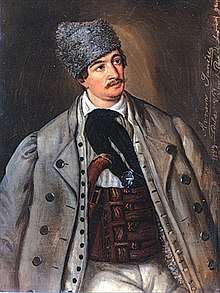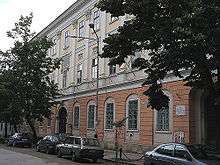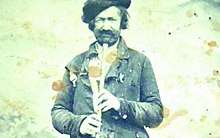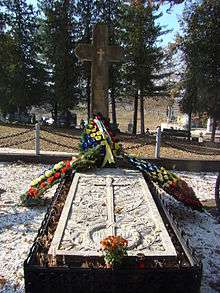Avram Iancu
Avram Iancu (Romanian pronunciation: [aˈvram ˈjaŋku]; 1824 – September 10, 1872) was a Transylvanian Romanian lawyer who played an important role in the local chapter of the Austrian Empire Revolutions of 1848–1849. He was especially active in the Țara Moților region and the Apuseni Mountains. The rallying of peasants around him, as well as the allegiance he paid to the Habsburg got him the moniker Crăișorul Munților ("The Prince of the Mountains").[1]


Early life
Avram Iancu was born in Vidra de Sus (currently Avram Iancu, Alba County), Transylvania, then part of the Austrian Empire into a family of peasants that had been emancipated from serfdom. His father was Alisandru Iancu[2] (1787-1855) and his mother was Maria Gligor.[3] He had one elder brother, Ion (born 1822), who became a priest.
Avram Iancu's grandfather was Gheorghe Iancu[4] (deceased before 1812), who had seven children (four girls and three boys): girls - Sântioana, Maria, Zamfira and Ana; boys - Alisandru (the father), Avram and Ioan.
Little is known today about Avram Iancu's childhood. It is known, by local tradition, that he had a typical moț character, joyful and witty and he played well the leaf, alphorn, flute and violin.
Avram Iancu attended primary school in his village, in the "Târsa" hamlet. His teacher was Mihai Gomboș. After a while, he was sent by his parents at the school in Neagra (now Poiana Vadului) village. Further, he attended the school from Câmpeni, Alba county, his teacher being Mihai Ioanette. He graduated the Câmpeni school at age 13.
After this, he went to school in Zlatna, where he studied in a Hungarian school, in the Latin language, as Romanian schools didn't exist in this area. His teachers were Iozephus Stanken (1837-1838), Gregorius Iakabus (1838-1839) and Ludovicus Kovács (1839-1840 and 1840-1841). He graduated at age 17.
He studied humanities from 1841, in the Piarist College of Cluj, graduating law school.
Initial stages of 1848 Revolutions
Avram Iancu became a law clerk in Târgu Mureș, and it was there that he learned about the events of March 1848 of Vienna and Pest. His attitude at the time showed the nature of the conflict that was to engulf Transylvania: while Iancu welcomed the transition, he was indignant at the fact that Hungarian revolutionaries (many of whom were landowners) refused to debate the abolition of serfdom (which at the time was the state of the larger part of the Romanian population in Transylvania).[5]
In the Apuseni Mountains, he started rallying peasants in Câmpeni. The protests he organized were recognized as peaceful by the authorities, but nevertheless worried them. Iancu and his associate Ioan Buteanu quickly became the main figures of the Romanian-led actions in the area, especially after they took part in the Blaj Assemblies starting in April, where over 40,000 Romanians met to protest against Transylvania becoming a part of Hungary.[6] In Blaj (Hungarian: Balázsfalva; German: Blasendorf) both opted for the main, radical wing of the movement. Centered on Alexandru Papiu Ilarian, the group opposed the Hungarian revolutionary option of uniting Transylvania and Hungary. It got into conflict with the minority wing around Greek-Catholic Bishop Ioan Lemeni, one which chose not to boycott the elections for the Hungarian Parliament.
While the union was carried of on May 30, 1848, the majority of Romanian activists looked towards Vienna and Emperor Ferdinand, sharing the cause of the Transylvanian Saxons. Things became heated after July 11, when Hungary declared its independence. Austria started to open itself to the Romanian demands, while bloody conflicts ensued between the Hungarian nobles and their Romanian serfs. The last Assembly in Blaj saw the Habsburg governor, Anton Freiherr von Puchner, approve of the arming of National Guards for Romanians and Saxons. On September 27, the lynching of Austrian plenipotentiary Count Lemberg by a Pest crowd cut off any dialogue between the two centers. The new Emperor Franz Joseph and the Austrian government granted the Romanians numerous liberties and rights; although Lajos Kossuth's government abolished serfdom, this was no longer a match for the Imperial offer.
Conflict
| Transylvanian Revolution | |||||||
|---|---|---|---|---|---|---|---|
| Part of the Hungarian Revolution of 1848 and the 1848–49 massacres in Transylvania | |||||||
| |||||||
| Belligerents | |||||||
|
|
| ||||||
| Commanders and leaders | |||||||
|
|
| ||||||
| Strength | |||||||
|
4,000 troops of the "Auraria Gemina" Legion[7] Unknown amount of Austrian soldiers | 10,000 troops (a third of the Hungarian Army in Transylvania)[8] | ||||||
| Casualties and losses | |||||||
| Unknown | 5,500[9][10] | ||||||
Outbreak
The Austrians clearly rejected the October demand that the ethnical criteria become the basis for internal borders, with the goal of creating a province for Romanians (Transylvania grouped alongside Banat and Bukovina), as they did not want to replace the threat of Hungarian nationalism with the potential of Romanian separatism. Yet they did not declare themselves hostile to the rapid creation of Romanian administrative offices within Transylvania.
The territory was organized in prefecturi ("prefectures"), with Avram Iancu and Buteanu as two prefects in the Apuseni. Iancu's prefecture, the Auraria Gemina (a name charged with Latin symbolism), became the most important one as it took over from bordering areas that were never really fully organized.
In the same month, the administrative efforts were put to a halt, as Hungarians under Józef Bem carried out a sweeping offensive through Transylvania. With the discreet assistance of Imperial Russian troops, the Austrian army (except for the garrisons at Alba Iulia and Deva) and the Austrian-Romanian administration retreated to Wallachia and Wallachian Oltenia (both were, at the time, under Russia's occupation).
Attrition
On 8 November, Avram Iancu, along with his 4,000 combatants of the "Auraria Gemina" Legion took part in joint military actions with Austrian forces. The Legion reached Turda, and the city surrendered without a fight on 20 November. Then, he and his troops returned to the mountains.[11] On 29 November, Avram Iancu had another 1,500 troops mobilized for action. On 4 December, he reached Săcuieu, and on 6-7 December, he and his men were ordered to attack the enemy lines by surprise. However, the attack failed, due to the incompetence of an Austrian officer, and the Romanians were forced to withdraw by 10 December.[11] By early January 1849, the control over Transylvania was almost entirely regained by the Hungarian Army. The Romanian fighters holding out in their mountains stronghold were running low of supplies, having only 800 rifles to arm a few thousand men, and were completely surrounded by Hungarian troops by the end of March.[12][11]
In April 1849, Iancu was approached by the Hungarian envoy Ioan Dragoş (in fact, a Romanian deputy in the Hungarian Parliament). Dragoș appeared to have been acting out of his own desire for peace, since Iancu's troops were tying down too many Hungarian troops, about 10,000, a third of the Hungarian Army in Transylvania, according to Hungarian general János Czecz.[8] He worked hard to get the Romanian leaders to meet him in Abrud and listen to the Hungarian demands. Iancu's direct adversary, Hungarian commander Imre Hatvany, seems to have taken profit on the provisional armistice to attack the Romanians in Abrud.[13] He did not, however, benefit from a surprise, as Iancu and his men retreated and then encircled him. In the meanwhile, Dragoș was lynched by the Abrud crowds, in the belief that he was part of Hatvany's ruse.
Hatvany also angered the Romanians by having Buteanu captured and murdered. While his position became weaker, he was permanently attacked by Iancu's men, until the major defeat of May 22. Hatvany and most of his armed group were massacred by their adversaries, as Iancu captured their cannons, switching the tactical advantage for the next months. Hatvany's troops lost 5,000 soldiers and all of their artillery.[9][5][13] Kossuth was angered by Hatvany's gesture (an inspection of the time dismissed all of Hatvany's close collaborators), especially since it made future negotiations unlikely.
On 8 June, the Romanian stronghold in the mountains was attacked by the largest Hungarian force yet: 4,000 men supported by 19 cannons led by General Kemeny Farkas. The battle lasted between 11 and 17 June and ended in a crushing victory for the Romanians, the Hungarians having at least 500 troops killed during the battle.[10]
The Russian intervention in June precipitated events, especially since Poles fighting in the Hungarian revolutionary contingents wanted to see an all-out resistance to the Tsarist armies. People like Henryk Dembiński mediated for an understanding between Kossuth and the Wallachian émigré revolutionaries. The latter, understandably close to Avram Iancu (especially Nicolae Bălcescu, Gheorghe Magheru, Alexandru G. Golescu, and Ion Ghica) were also keen to inflict a defeat on the Russian armies that had crushed their movement in September 1848. Fighting also continued in July, during the peace negotiations, on 2, 4, and 22 July, all Hungarian attacks being repulsed yet again. Finally, the conflict ended on 29 July, as Avram Iancu offered a guarantee to the Hungarian troops that he would not attack them, allowing them to withdraw in front of the Austro-Russian offensive.[14]
Negotiations
Bălcescu and Kossuth met in May 1849, in Debrecen. The contact has for long been celebrated by Romanian Marxist historians and politicians: Karl Marx's condemnation of everything opposing Kossuth had led to any Romanian initiative being automatically considered "reactionary". In fact, it appears that the agreement was in no way a pact: Kossuth meant to flatter the Wallachians, by getting them to champion the idea of Iancu's armies leaving Transylvania for good, in order to help Bălcescu in Bucharest. While agreeing to mediate for peace, Bălcescu never presented these terms to the fighters in the Apuseni. His personal documents (commented by Liviu Maior) show that the un-realistic assumptions of Kossuth had made him view the Hungarian leader as a "demagogue".[15]
Even more contradictory, the only thing Avram Iancu agreed to (and which no party had asked for) was his forces' "neutrality" in the conflict between Russia and Hungary.[15] Thus, he secured his position as the Hungarian armies suffered defeats in July, culminating in the Battle of Segesvár (Sighişoara), and then the capitulation of August 13.
Later years

Avram Iancu agreed to disarm as soon as the Austrians took over, and wrote a detailed report to the new governor of Transylvania, General Ludwig von Wohlgemuth (in 1850). In order to avoid suspicion of Romanian separatism, the document does not mention the contacts with the Wallachians. As the Austrians granted the abolition of serfdom, they also forbade all representative institutions in Transylvania. While Hungarian nationalism was slowly fitting in the pattern that would make the Ausgleich acceptable for both sides involved, the Romanian option raised more and more irritation. The revolutionary zeal it had found under Iancu, although profiting the Monarchy, could also prove to be a weapon used for very different goals (the Austrians were especially fearful that the Greek Orthodox faith of the Romanians would accommodate itself with Pan-Slavism, completing the gap between Serbia and the Russian Empire).
It is very possible that Iancu was not able to properly observe the new status quo. While the decision for his initial arrest (in December 1849) was quickly overturned after local protests (and explained as an abuse), he was censored throughout his life, had his library confiscated, and was placed under surveillance. He was even arrested a second time, in 1852, after it was presumed that his presence alone served to inflame local sentiments. Local traditions [16]hold that the emperor Franz Joseph was visiting Transylvania and on July 21st, 1852 he was in the Apuseni Mountains area, purportedly to attend The Maidens' Fair on Găina Mountain but also hoping that Iancu would agree to meet him. Allegedly, Iancu refused, uttering his famous line "It's all for naught, a madman and a liar can't by any means come to understand each other". Soon after his release, Iancu visited Vienna and attempted to petition the Emperor. He was prevented to do so by the police, a public humiliation which provoked a nervous breakdown that had an impact on the rest of his life. He was marginalized by the authorities who didn't allow Romanians to have their own say in Transylvania about their own autonomy. Being treated as peripheral by the people in power, he spent the rest of his life traveling the Apuseni Mountains, as a half-mad vagrant, living out of whatever alms that the impoverished moți population could spare for him, singing sad Romanian doina songs on his flute.

Avram Iancu died on September 10, 1872 at Baia de Criș. His body was buried, according to his wish, under Horea's tree in Țebea (by tradition, the place where the Revolt of Horea, Cloșca and Crișan had started).[1]

Avram Iancu was officially declared as a Hero of the Romanian Nation in November 2016 by the Romanian Parliament and the president Klaus Iohannis.[17]
References
- Ion Ranca, Valeriu Nițu, Avram Iancu: documente și bibliografie, Bucharest, Editura Științifică, 1974 (most contemporary documents about Avram Iancu, including his report to Wohlgemuth)
- Dudaș, Florian (10 March 1989). "Avram Iancu în tradița poporului român". Editura Facla – via Google Books.
- Lupaș, Ioan; Vlasiu, Marina; Constantiniu, Florin (10 March 1988). "Din istoria Transilvaniei". Editura Eminescu – via Google Books.
- ""Gheorghe Iancu" "avram iancu" - Google Search". www.google.com.
- Ioan N. Ciolan, Constantin Voicu, Mihai Racovițan, "Transylvania:Romanian history and perpetuation, or, what official Hungarian documents say", Military Publishing House, 1993
- Stoica, Vasile (1919). The Roumanian Question: The Roumanians and their Lands. Pittsburgh: Pittsburgh Printing Company. p. 23.
- Dragomir 1968, pp. 104-105
- Czecz János (1850), Bem’s Feldzug in Siebenbürgen in den Jahren 1848 und 1849, Hamburg, p. 32
- Dragomir 1968, pp. 188-192
- Dragomir 1968, pp. 209-216
- Dragomir 1968, p. 118
- Dragomir 1968, p. 117
- Keith Hitchins, Românii 1774-1866, Bucharest, Humanitas, 1996
- Dragomir 1968, pp. 270-271
- Liviu Maior, 1848-1849. Români și unguri în revoluție, Bucharest, Editura Enciclopedică, 1998
- http://www.curentul.net/2015/03/15/apel-la-memoria-romanismului-replici-celebre-ale-lui-avram-iancu/
- "Iohannis a promulgat legea prin care Avram Iancu este proclamat «Erou al Naţiunii Române»". revista22.ro.
External links
![]()